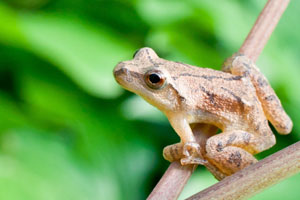
By Sarah Wilson, MA
When the cold comes, our Spring Peepers nestle under a log or into fallen leaves to ride out the winter. There they become frogsicles until they hop back to life in the spring. How?
Anyone who has mistakenly frozen a can of soda knows all about one of the biggest challenges: frozen liquid expands. An icy can deforms and sometimes bursts.
If you think of every cell in your body as such a can, the problem is obvious. If cells were to freeze, all that expansion and bursting would destroy tissues. We mere mammals get frostbite, why not the frog?
What if you could siphon some of that freezable liquid out of those cells? What if you could make the remaining liquid harder to freeze? Turns out, that’s exactly what the frog does.
The moment any ice forms on the frog’s skin, its body goes on full alert. Adrenaline cues the liver to convert glycogen (stored carbs) into glucose (sugar) — a lot of glucose. A freezing frog can have a blood sugar level hundreds of times higher than our human average. Glucose levels that would promptly poison people, do not harm our precious Peepers.
As that glucose-rich blood circulates, it does two important things: remove water from the cells so they don’t burst and concentrate the glucose inside the cells so they don’t freeze solid. Once that good work is done, the frog’s systems shut down. Their heart and lungs stop, the water outside the cells freezes and our frog friend becomes a brilliantly adapted amphibian ice cube until spring.
There is much we do not yet know about this suspended animation; what we do know is that, as the temps rise, these neighbors of ours thaw out and live to croak again.
Nature is amazing.


